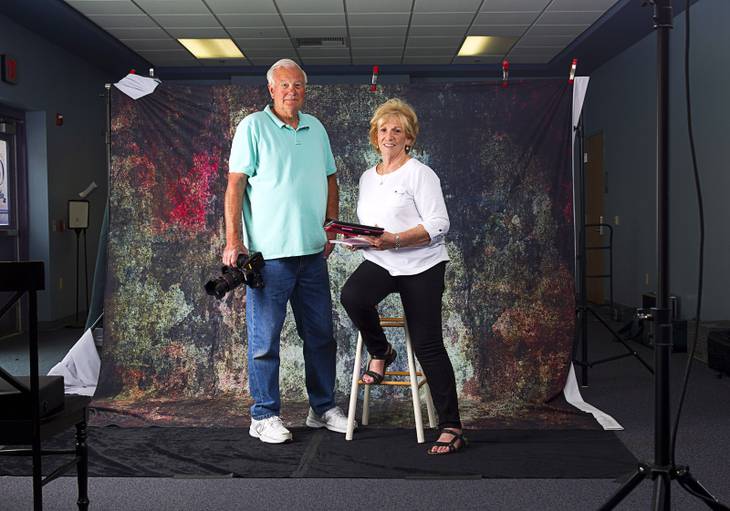It’s senior-class portrait season, and Anita and Jim Ziegler have set up a makeshift photo studio, right down to an iPad for instant retouching, in the lobby of the Canyon Springs High School auditorium.
A handful of seniors file in. Some wear caps and gowns.
This is a special group, selected by their school counselor for excelling in their studies despite challenges at home. Now they’ll be rewarded with an 8x10, two 5x7 and eight wallet-sized photos, courtesy of the Zeiglers, owners of Sandstone Photography.
This is how the small-business owners give back to the community.
Last year, they made portraits of 88 students from 18 schools. They enjoyed it so much that this year they planned to photograph 135 students from 24 schools.
The Zieglers’ reward? They get to see the students’ smiles when they show the results. Jim Ziegler recalled a student who told them, “My parents would have never been able to have pictures of me if you hadn’t done this.”
“I’ve never been told that, and to us, it was such a nice feeling,” Anita said.
The Zieglers connected with school counselors through the Clark County School District’s School Community Partnership program. It serves as a matchmaker for companies small and large that want to offer time, talent or treasures to local youths. The Zieglers are in their second year of volunteering; Nevada Title Company has been doing it for 25 years.
Nevada Title partnered with Ira J. Earl Elementary School, not far from Nellis Air Force Base. Employees conduct an annual school supply drive at the start of each school year, filling backpacks with paper, binders, crayons, toothpaste and shampoo, which they then deliver to students.
The company’s focus this time of year is mentoring fifth-grade students by writing them weekly emails offering encouragement. Lisa Brown, who oversees education and employee development for Nevada Title, said employees look forward to exchanging emails with the youngsters, who get a chance to practice their writing and typing skills.
“I mentor three fabulous kids who are the same age as my grandson,” Brown said. “We talk about their day or special projects at school, or we hear whether there’s a bully.”
The e-mentoring turns face to face on Mentor Meet Day, when Nevada Title staff hosts a pizza lunch for the kids.
Nevada Title owner Terrance Wright said the sense of pride employees feel after engaging in community projects is profound.
And “it is greater when they (volunteer) themselves, as opposed to the company simply writing a check to the school,” Wright said.
Employees’ interaction with the children is one of the highlights of their jobs. Brown said their involvement “has made staff community-minded and reminds them there is something larger outside of work.”

Jim Ziegler of Sandstone Photography takes a photo of graduating senior during a portrait session at Canyon Springs High School in North Las Vegas Tuesday, March 17, 2015. Jim and his wife Anita volunteer their time to take free photos of selected graduating seniors who otherwise can't afford to have them taken.
Employees at other Las Vegas businesses have adopted philanthropic campaigns that benefit organizations other than schools. Many connect with beneficiaries through the United Way of Southern Nevada.
“Some of Southern Nevada’s most innovative, community-minded and successful companies have stepped forward to run a United Way workplace campaign,” agency President Cass Palmer said.
It’s easy to lend a hand in the community, Palmer said.
“All they have to do is bring the manpower,” he said.
How to run a successful workplace giving campaign
■ Get the boss’s approval. He or she may encourage you and offer assistance or discourage the effort.
■ Contact your human resources and/or payroll departments to set up automatic withdrawals for employees who want to donate money to organizations such as the United Way.
■ Know your audience. The level and type of volunteerism your colleagues commit to likely will be driven by the demographics of your workplace. Millennials may be more inclined to participate in fundraising marathons or mudders, whereas older workers may prefer reading books to children or collecting winter coats for the homeless.
■ Keep in mind that some campaigns may be conducted once a year while others require a series of events.
■ Let employees choose which charity will receive donations, and reach out to retired co-workers who may want to participate.
■ Include management and executives who can show their support by publicizing the event, making a “pacesetter” donation at the kickoff, encouraging employee involvement or pitching in to help.
■ Designate a campaign team to brainstorm, drum up support, provide direction and set goals, which are crucial for any long-term project. Make sure the goals are realistic and attainable, yet challenging. Goals may include overall dollars raised, dollars raised by department, participation rate or average gift. Employee committees encourage a team approach and inspire others to get involved.
■ Publicize the campaign before kickoff to increase donor awareness and create visible reminders throughout the campaign and year-round. United Way and Earthshare both noted that the No. 1 reason people fail to give is because they weren’t asked or didn’t know about the opportunity.
■ Show progress with campaign newsletters or displays (such as thermometers) that chart the growing amount of contributions. Tie progress reports to your business’s theme. For instance, if you sell cars, chart progress on a racetrack.
■ Ask the beneficiary of the campaign for feedback. Or better yet, invite the beneficiaries to your workplace to share stories about how donations have helped. Speakers and videos can put a face to the donation and allow employees to see the impact they can have in their community.
■ At the end of the campaign, celebrate companywide and recognize vital donors and employees who made the campaign a success. Thank generous supporters with small gifts that carry the campaign name, such as pens or pencils. Thank key campaign leaders for their hard work.
Sources: United Way, Moonridge Group, Earthshare

